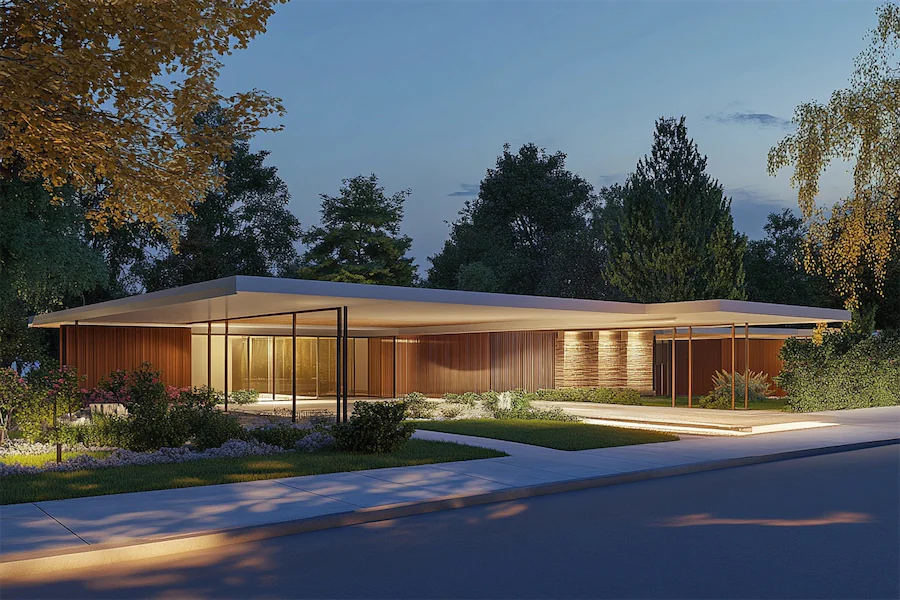Mid-century modern architecture, which flourished from the 1940s to the 1960s, is renowned for its emphasis on simplicity, functionality, and a harmonious connection with nature. A defining characteristic of this architectural style is its innovative roof designs, which not only contribute to the aesthetic appeal but also enhance the structural integrity and environmental responsiveness of the buildings.
History and Origins of Mid-Century Modern Roofs
The mid-century modern movement emerged in the post-World War II era, a time marked by rapid technological advancements and a desire for progressive design. Architects sought to break away from traditional forms, embracing new materials and construction techniques. This period saw the introduction of unconventional roof designs that challenged the norms of residential architecture. For instance, the butterfly roof, characterized by its V-shape resembling a butterfly’s wings, was popularized in the late 1950s in Palm Springs, California. This design not only provided a distinctive silhouette but also facilitated efficient rainwater collection.
Key Features of Mid-Century Modern Roofs
Mid-century modern roofs are distinguished by several innovative features:
- Flat and Low-Pitched Roofs: Departing from traditional steeply pitched roofs, mid-century designs often featured flat or gently sloping roofs. This approach created a sleek, horizontal profile that blended seamlessly with the surrounding landscape. Despite their appearance, these roofs typically incorporated a slight tilt to facilitate water drainage.
- Butterfly Roofs: This design consists of two roof surfaces sloping downwards to a central valley, forming a V-shape. Beyond its striking visual impact, the butterfly roof was practical for rainwater harvesting and allowed for larger windows, enhancing natural light within the interior spaces.
- Gabled and Single-Slope Roofs: Some mid-century modern homes incorporated traditional gabled roofs with a modern twist, featuring low slopes and wide overhangs. Single-slope (or shed) roofs, where one plane slopes from one side of the building to the other, were also prevalent, contributing to the asymmetrical and dynamic forms characteristic of the style.
Applications of Mid-Century Modern Roofs
The distinctive roof designs of mid-century modern architecture were applied across various residential structures, including:
- Single-Family Homes: Emphasizing open floor plans and a strong indoor-outdoor connection, these homes often featured expansive roof overhangs that provided shade and sheltered outdoor living areas.
- Prefabricated Houses: The post-war housing demand led to the development of prefabricated homes with modular components. Innovative roof designs were integral to these structures, offering both aesthetic appeal and functional benefits.
- Experimental Structures: Architects of the era, such as those involved in the Case Study House program, explored unconventional roof forms to push the boundaries of residential design, resulting in iconic structures that continue to influence contemporary architecture.
Considerations When Choosing a Mid-Century Modern Roof
When selecting or renovating a mid-century modern roof, several factors should be considered:
- Climate Adaptation: Flat and low-pitched roofs are best suited for arid climates where water drainage is less of a concern. In regions with heavy rainfall or snowfall, additional measures, such as enhanced waterproofing and structural reinforcement, are necessary to ensure durability.
- Material Selection: The choice of roofing materials significantly impacts both the performance and appearance of the roof. Options include built-up roofing (BUR) systems, which are traditional choices for flat or low-slope roofs, and modern materials like single-ply membranes that offer improved durability and energy efficiency.
- Maintenance Requirements: Unique roof designs may require specialized maintenance to address issues such as drainage, insulation, and structural integrity. Regular inspections and prompt repairs are essential to preserve the roof’s functionality and aesthetic appeal.
Conclusion
Mid-century modern roofs are emblematic of a transformative period in architectural history, reflecting a shift towards innovation, simplicity, and harmony with the environment. Their distinctive designs continue to inspire contemporary architecture, offering timeless solutions that marry form and function. Understanding the historical context and key features of these roofs enables homeowners and designers to appreciate and preserve the legacy of mid-century modern architecture.
